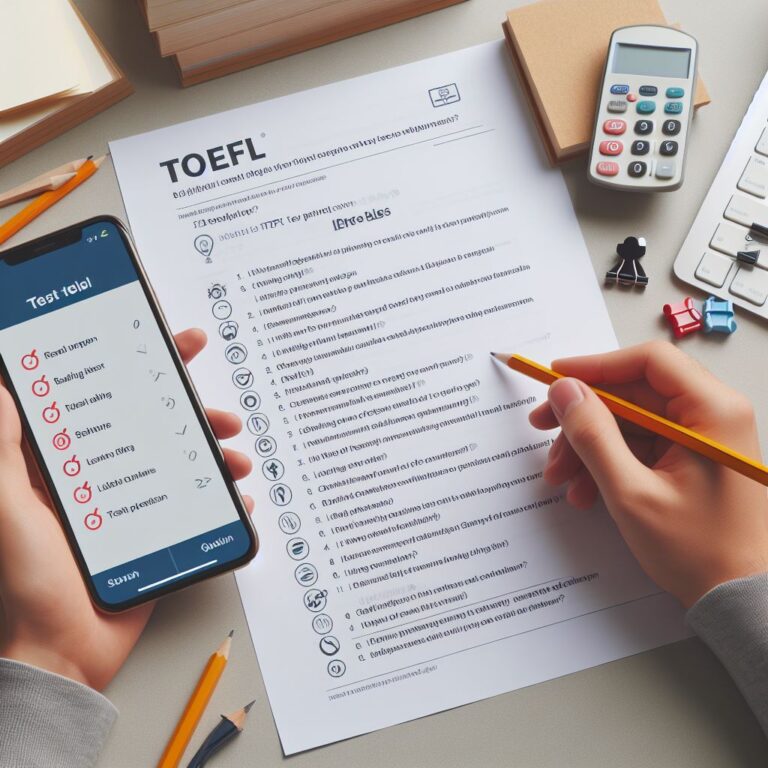TOEFL Speaking Question 1

Key Points
Personal Choice Prompt: The first question typically involves a personal choice or preference, serving as an easy warm-up to the speaking section.
Response Structure: Answers should be well-organized, starting with a clear choice followed by reasons and examples, using appropriate connectors like “also,” “and,” or “but.”
Language Use: Effective responses require correct grammar, vocabulary, clear pronunciation, and a good speaking pace, with an emphasis on fluency and coherence.
What you will find in this guide:
TOEFL Speaking Question 1, the Independent Task
In the first speaking question of the TOEFL iBT exam, you will get a prompt about a personal choice or preference. This question serves as a warm-up exercise to ease you into the speaking section and is considered the easiest task among the speaking prompts. Your primary objective in this task is to express your opinion and provide support for your viewpoint.
TOEFL Speaking Question 1, is your opportunity to shine by expressing your ideas, opinions, and experiences1. This question asks you to state a choice among two possible situations, actions, or opinions on a general-interest or campus-related topic2. It’s a chance to speak about a familiar topic3 and demonstrate your ability to speak English effectively in academic settings2.
In this blog post, we will delve into the structure of the question, explore different question types, and discuss the scoring criteria. We will also provide a step-by-step guide to answering TOEFL Speaking Question 1 and share valuable tips and strategies to help you prepare and deliver your response effectively.
Understanding Question 1
The TOEFL Speaking Question 1, is your first challenge in the TOEFL speaking section and it’s crucial to grasp its essence for a high score.
TOEFL Speaking Question 1 is often referred to as the “personal choice” question4. It’s designed to assess your ability to express your ideas, opinions, and experiences in English. The question will ask you to state a choice among two possible situations, actions, or opinions on a general-interest or campus-related topic.
The beauty of this question lies in its simplicity. You’re asked to speak about a familiar topic. This could be related to school, work, or some other part of life. Commonly, this question asks if you agree or disagree with a given statement.
The structure of TOEFL Speaking Question 1 is straightforward. You have 15 seconds to prepare and 45 seconds to speak. That’s a total of 60 seconds2. While it might seem daunting at first, with the right approach and plenty of practice, you can master this task.
Question Types
Now that we’ve understood the basics of TOEFL Speaking Question 1, let’s delve into the different question types you might encounter. Understanding these types is crucial as it helps you prepare your responses effectively.
There are four main question types in TOEFL Speaking Question 1. Each of them asks for your opinion, but the way they’re framed varies. Let’s explore each of these types:
Personal Preference: This type of question asks you to express a preference between two or more options. For example, “Would you prefer to work at one job your entire life or switch jobs every five years?”1. The key here is to choose a side and stick to it.
Agree or Disagree: In this type, you’ll be presented with a statement and asked whether you agree or disagree1. For instance, “Do you agree or disagree with the following statement? All high school students should wear school uniforms.”1. It’s important to clearly state your stance and provide reasons to support it.
Three Choices: Here, you’ll be given three options and asked to choose one. For example, “For your last assignment, the professor expects you to create a presentation. You can work alone, with a partner, or with a group. Which would you choose?”1. Be sure to justify your choice with relevant examples.
Advantages and Disadvantages: This type asks you to discuss the pros and cons of a given situation. For example, “Some teenagers work while attending high school. Please discuss the advantages and disadvantages of having a part-time job while in school.”1. It’s crucial to provide a balanced view, discussing both the positive and negative aspects.
Remember, no matter the question type, your goal is to express your opinion clearly and coherently.
Scoring Criteria
Understanding the scoring criteria for TOEFL Speaking Question 1 is crucial to achieving a high score. In this section, we’ll delve into how your responses are evaluated.
TOEFL Speaking responses are scored based on three main components:
Delivery: This refers to how clearly and intelligibly you speak. It includes aspects like pronunciation, flow, intonation, and pacing. A well-delivered response is fluid, with little hesitation or self-correction. The rate of speech is appropriate, and intonation and pausing are used to group words in meaningful phrases. Even minor mispronunciations or other-language influences may be present, as long as they do not impair intelligibility.
Language Use: This measures how well you use grammar and vocabulary to express yourself. A high-scoring response demonstrates effective use of grammar and vocabulary. It exhibits a fairly high degree of automaticity with good control of basic and complex structures. Some minor (or systematic) errors are noticeable but do not obscure meaning.
Topic Development: This evaluates how well you develop your ideas in response to the task. A high-scoring response is sustained and sufficient to the task. It is generally well developed and coherent; relationships between ideas are clear. The response fulfills the demands of the task, with at most minor lapses in completeness.
Each of these components is equally important, and you should aim to perform well in all of them for a high score.
Human raters will assign each task a score from 0 to 4 in whole numbers. These scores are then averaged together to give you a raw score for the task, also on a scale of 0-4. Finally, your raw scores for each of the six tasks are averaged together and converted to a final scaled Speaking score on a scale of 0-30.
Remember, the key to a high score in TOEFL Speaking Question 1 is not just about what you say, but also how you say it. In the next section, we’ll provide a step-by-step guide to answering TOEFL Speaking Question 1 effectively.
Guide to TOEFL Speaking Question 1
To answer the question, follow these steps:
Step 1: Read the Question Well. This helps you understand what to talk about.
Step 2: Say Your Opinion right after reading the question. Your opinion doesn’t have to be “right” because there are no correct answers. They want to see how well you talk, not what you think is best. Pick a side, like if you like something or not.
Step 3: Think of Two Good Reasons. Once you know your opinion, think of two reasons to support what you think. Think about things that make sense and can help others understand your opinion. These reasons should be clear and make sense.
Step 4: Give Examples to Support. To make your reasons stronger, tell a story or give examples. This could be something you’ve experienced, seen, or just know about. The more details you add, the better your answer will be. Remember, the goal is to explain your opinion well.
Step 5: Choose the Right Words and Grammar. After you have your main points, choose words that say what you want clearly. Use words that fit, and don’t say the same thing too much. Use words like “and,” “because,” or “but” to connect your ideas. Check that your sentences sound right and use the right words in the right way.
Recommended Planning
Use the triangle strategy to plan your response.

Tips
- Don’t repeat words many times. Use different synonyms.
- Include two reasons
- Use transition phrases like “as a result,” “consequently,” “moreover,” and “therefore” to link ideas.
- Use a mix of simple and compound sentences.
- Don’t try to use sophisticated words and structures in this part, it’s not necessary. Just speak normally and naturally.
- Use Speaking Templates to practice for the exam!
Practice Questions
Now that you know about the TOEFL speaking question 1, it is a good idea for you to practice speaking using sample questions. So, use the questions below to practice speaking. You can record your voice and then evaluate your speaking using the speaking checklist I have created for this purpose. Speaking checklist linked here. Using this checklist makes you aware of the features you need to show in your response and gives you an idea of what you need to put more effort and work on. Good luck!
Practice Test Questions:
Here are seven TOEFL speaking part 1 questions:
“Some people prefer to live in a bustling city, while others prefer the quiet of the countryside. Which do you prefer? Include details and examples to support your explanation.”
“When it comes to learning a new skill, some people prefer to take a class, while others prefer to learn on their own through books and online resources. Which approach do you prefer? Include details and examples to support your explanation.”
“Some people prefer to plan their free time carefully, while others prefer to be spontaneous. Which do you prefer? Include details and examples to support your explanation.”
“When it comes to staying informed about current events, some people prefer to read newspapers, while others prefer to watch news on television or online. Which do you prefer? Include details and examples to support your explanation.”
“Some people prefer to work on a team, while others prefer to work independently. Which do you prefer? Include details and examples to support your explanation.”
“When it comes to exercise, some people prefer to work out at a gym, while others prefer to exercise outdoors. Which do you prefer? Include details and examples to support your explanation.”
“Some people prefer to cook at home, while others prefer to eat out. Which do you prefer? Include details and examples to support your explanation.”






